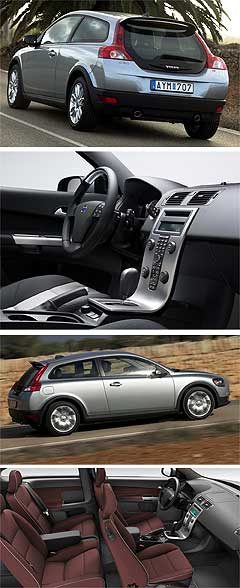Future models - Volvo - C30First drive: Volvo C30 dressed to impressHow Swede it is: The C30 is tipped to arrive here priced from $35,000. Volvo draws on iconic P1800ES hatch for C30 inspiration27 Nov 2006 VOLVO has clearly stepped right out of its comfort zone with the C30 hatch. It is clear Volvo designers have aimed the car’s funky looks and cool four-seater interior directly at buyers who would normally opt for an Audi A3, BMW 1 Series, VW Golf GTi or Mini Cooper. No Volvo previously has afforded the levels of individualisation that will be offered in the new hatch. With more than 50 different interior and exterior colour and trim combinations, the Swedish car-maker wants to lure younger, hip buyers who appreciate design and function as well as safety and performance. Prices are expected to start from $35,000 for the entry five-speed manual 2.4i model, rising to about $45,000 for both the up-spec 2.4-litre D5 and 2.5-litre T5 models. The car has already won three design awards in Europe and Volvo’s chief designer at the company’s Barcelona design studio, David Ancona, believes the four-seater hatch will change perceptions of the Swedish company. Volvos may once have been driven by "university professors and vicars" but the C30 represents a refreshingly new approach, he says. With design cues from the Safety Car Concept (SCC) and C30 design concept shown at this year’s Detroit motor show and a rear glass hatch that pays homage to the P1800ES, the C30 is the fourth model off the C1 platform architecture that has delivered the S40, V50 and just-released C70. Visually, the C30 retains the dynamic character of the S40 with angled headlights and low, wide grille. However, from the side the roofline is distinctly coupe-esque with a "boat-shape" roof and window line, created by narrowing the roof and widening the shoulder line at the rear. The distinct, standard black wheel housing and sills echo the Mini Cooper. These sills can also be ordered in different colours with a body kit. The car has been deliberately designed as a four-seater, with separate, individually folding rear seats. No five-door version is planned. Inside, the front pews and "floating" dashboard are similar to the C70/S40 and the front seats use the same sliding electric adjustment as the cabrio. To access the rear seats electric buttons on the seatback move the seats forward while a flip release levers forward to allow easy access to the rear. The tapered design of the B-pillar also contributes to the easy entrance. The rear seats are divided by a folding armrest and are positioned slightly inwards of the side to provide more elbow space and improved forward view. As the car is based on the S40, there is the usual high level of passive and active safety features. Standard equipment is expected to include dual stage front, plus side and curtain airbags, climate control air-conditioning, multi-function steering wheel, cruise control, fabric trim (on the 2.4i), three-spoke sports leather steering wheel, brushed aluminum centre console, alloy pedals, front and rear fog-lights, rear spoiler, trip computer, ABS, SIPS side protection, four-wheel disc brakes, 16-inch alloys, dual exhausts, 50/50 split fold rear seats, eight speaker CD stereo with MP3 and Ipod compatibility. Options are expected to include dynamic stability traction control, a satellite navigation, body kit, sunroof, BLIS blind spot detection system, laminated side windows, cargo cover and body kit while the T5 is tipped to add leather seats, 17-inch alloys and DSTC as standard. Like the S40 – which shares its suspension with the Ford Focus and Mazda3 – the C30 has a MacPherson strut front suspension with a multi-link rear axle. The steering is electro-hydraulic with a sharper tune than the S40. The 2.4i develops 125kW at 6000rpm and 230Nm at 4400rpm, endowing the car with a zero to 100km/h sprint of 8.1 seconds for the five-speed manual (8.8 auto) and top speed of 220km/h (215km/h auto). The combined fuel figure is 8.4L/100km for the manual and 9.0L/100km for the auto. The 2.4-litre D5 turbo-diesel, shared with the XC90, develops 132kW at 4000rpm and 350Nm from 1750rpm. The D5 automatic hits 100km/h in 8.4 seconds and has a top speed of 220km/h. Its combined fuel economy figure is 6.9 seconds. The hot 2.5-litre T5 develops 162kW at 5000rpm and 320Nm between 1500rpm and 4800rpm. It has a combined fuel economy figure of 8.7L/100km (9.4L/100km auto). The D5 and T5 will be available with either six-speed manual or five-speed Geartronic sequential automatics.  At present, there are no plans to introduce an all-wheel drive T5 model even though AWD is offered on the V50. At present, there are no plans to introduce an all-wheel drive T5 model even though AWD is offered on the V50.Volvo Australia spokesman, Todd Hallenbeck, said he expects the 2.4i model to be the volume seller but the D5 would also garner strong buyer interest. "But the D5 and T5 will be positioned attractively," he said. Mr Hallenbeck said Volvo Australia was aware the C30 would need to be price competitive with not only its key rivals but also the S40 range, which starts at $39,950 for the 2.4S. "We also expect it to draw down the average age of a Volvo owner because it will appeal to a wider audience," he said. Volvo expects to sell 65,000 C30s globally a year with 75 per cent of sales in Europe. Volvo Cars Australia aiming for a conservative 600 in its first 12 months on sale. The car goes on sale in March. Despite its compact format at 4250mm – 220mm shorter than the S40 – the C30 sits on the same 2640mm wheelbase as the S40/V50 and offers the same safety levels as its sedan and wagon siblings, with seating for four with two individual seats in the rear. In size the C30 is just 36mm shorter than an Audi A3 and 23mm longer than a 1 Series, while its wheelbase is 62mm longer than an A3 but 20mm shorter than a 1 Series. Its interior packaging affords a roomy cabin for four. The shorter length also means a slightly lighter body - 1204kg or 1404kg - depending on the model. Drive impressions: ARE Volvos supposed to be fun to drive? If you haven’t driven any of the newer Swedish offerings in recent times then you’re in for a shock. The S40 and V50 set a new envigorated agenda for Volvo, offering dynamic poise as well as contemporary design and now it’s the C30’s turn. As the two-door hatch shares its underpinnings with the S40 it comes as no surprise that the four-seater exhibits the same degree of chassis control and on-road poise that has established its sibling as a highly rewarding car. However, Volvo has managed to impart some crispness into the driveline. The C30’s steering feels more communicative and the ride crisper without losing its composure over poorly sealed roads. It was clear, after a 250km drive around Majorca in Spain, that this Volvo offers a distinctly sporty drive. Add to that its funky looks, and the C30 is building on what is now becoming accepted Volvo thinking on good design and dynamics. Sharing the platform with the S40/V50, which itself shares its architecture with the Ford Focus and Mazda3, the C30 already has a well-sorted chassis while the C30 also grabs the best Volvo engine’s off the shelf. For Australia that means three engines - the 2.4i, 2.5 T5 and 2.4 D5 turbo diesel with the 2.4i being the volume seller. In a meandering drive around the island of Majorca in the 2.5 T5 and 2.4 D5 – no 2.4is were available - the C30 exhibited all the positive handling traits of the S40 with the two-door’s slightly lighter weight aiding the car’s performance. The electro-mechanical steering had a new-found sense of feel and feedback with almost no kickback over potholes or corrugations and both the T5 and turbo-diesel offered plenty of mid-range acceleration. When pushed the C30 exhibits little understeer, tending towards neutral while the steering displayed a crisp turn-in. The four-wheel disc brakes, even when repeatedly punished exhibited no fad and offer positive stopping power. The ride, even with the T5’s sportier suspension setting, was an ideal balance of precision and suppleness. The C30’s ride comfort was complemented by its shapely and supportive seats, another Volvo trademark. Even in the rear, the hatch offers plenty of leg and headroom and the electric sliding and flip fold front seats allow easy access through the wide-opening doors. Volvo has specifically made the C30 a four-seater, which means rear passengers get seats just as good as those in the front. A fold-down centre armrest and low rear glass hatch window afford good rear visibility. At highway speeds the car’s cabin remained well muted, thanks largely to the laminated side glass, expected to be a $490 option in Australia. There was little wind noise and tyre noise was low. However, we await the opportunity to drive the C30 on Australia’s coarse chip roads before finally passing judgment. Perhaps the only dark cloud on the C30 horizon is the rear luggage area. Although both the rear seatbacks fold flat, the actual space is compact, shallow and impeded by the shape of the rear bumper and glass hatch. That’s a small price to pay for the neat rear-end design though. The C30’s rump is one of its more pleasing aspects, being faithful to the original concept car and paying homage to the original P1800 ES of the 1970s. The 2.5-litre turbo and D5 turbo-diesel emit a pleasing gruff growl peculiar to in-line five-cylinder engines but remain muted. The D5 is noisy around town but is quieter on the open road and the mountains of torque from low in the rev range delivers spirited performance. Volvo Cars Australia has conservatively forecast C30 sales of around 60 a month. However, like the Mini, we reckon it will lure a legion of new fans who’ll love its looks, they way it drives and the security of the Volvo badge. We’d suggest they better start thinking about cranking up production at the Ghent factory in Belgium, where the C30 is being built. The verve is back at Volvo, without sacrificing any of the brand’s expectations of safety, durability, quality, practicality and environmental responsibility. All future models Alfa Romeo Alfa Romeo Abarth Abarth Alpine Alpine Alpina Alpina Audi Audi Aston Martin Aston Martin BMW BMW Bentley Bentley Chery Chery Brabham Brabham Chrysler Chrysler Chevrolet Chevrolet Cupra Cupra Citroen Citroen DS DS Dodge Dodge Fiat Fiat Ferrari Ferrari Foton Foton Ford Ford Great Wall Great Wall FPV FPV Haval Haval GWM GWM Honda Honda Holden Holden Hummer Hummer HSV HSV Infiniti Infiniti Hyundai Hyundai Jaguar Jaguar Isuzu Isuzu Kia Kia Jeep Jeep Land Rover Land Rover Lamborghini Lamborghini Lexus Lexus LDV LDV Mahindra Mahindra Lotus Lotus Mazda Mazda Maserati Maserati Mercedes-AMG Mercedes-AMG McLaren McLaren MG MG Mercedes-Benz Mercedes-Benz Mitsubishi Mitsubishi Mini Mini Opel Opel Nissan Nissan Peugeot Peugeot Pagani Pagani Proton Proton Porsche Porsche Renault Renault Ram Ram Rover Rover Rolls-Royce Rolls-Royce Skoda Skoda Saab Saab SsangYong SsangYong Smart Smart Suzuki Suzuki Subaru Subaru Toyota Toyota Tesla Tesla Volvo VolvoMotor industry news |
Click to shareVolvo modelsResearch Volvo All future models Alfa Romeo Alfa Romeo Abarth Abarth Alpine Alpine Alpina Alpina Audi Audi Aston Martin Aston Martin BMW BMW Bentley Bentley Chery Chery Brabham Brabham Chrysler Chrysler Chevrolet Chevrolet Cupra Cupra Citroen Citroen DS DS Dodge Dodge Fiat Fiat Ferrari Ferrari Foton Foton Ford Ford Great Wall Great Wall FPV FPV Haval Haval GWM GWM Honda Honda Holden Holden Hummer Hummer HSV HSV Infiniti Infiniti Hyundai Hyundai Jaguar Jaguar Isuzu Isuzu Kia Kia Jeep Jeep Land Rover Land Rover Lamborghini Lamborghini Lexus Lexus LDV LDV Mahindra Mahindra Lotus Lotus Mazda Mazda Maserati Maserati Mercedes-AMG Mercedes-AMG McLaren McLaren MG MG Mercedes-Benz Mercedes-Benz Mitsubishi Mitsubishi Mini Mini Opel Opel Nissan Nissan Peugeot Peugeot Pagani Pagani Proton Proton Porsche Porsche Renault Renault Ram Ram Rover Rover Rolls-Royce Rolls-Royce Skoda Skoda Saab Saab SsangYong SsangYong Smart Smart Suzuki Suzuki Subaru Subaru Toyota Toyota Tesla Tesla Volvo VolvoMotor industry news |














Facebook Twitter Instagram